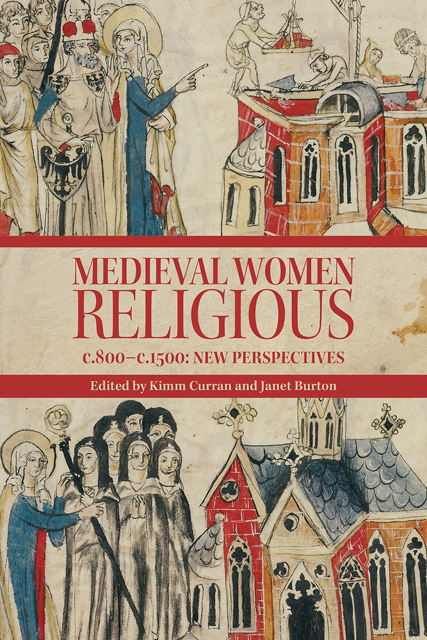Book contents
- Frontmatter
- Contents
- Illustrations
- Contributors
- Preface
- Abbreviations
- Introduction
- 1 Reform, Change, and Renewal: Women Religious in the Central Middle Ages, 800–1050
- 2 New Movements of the Twelfth Century: Diversity, Belonging, and Order(s)
- 3 Change and Renewal: Mendicants and Tertiaries in Later Medieval Europe
- 4 On the Fringes: Anchorites
- 5 ‘Quasi-religious’: Vowesses
- 6 Authority and Agency: Women as Heads of Religious Houses
- 7 Women Religious, Secular Households: The Outside World and Crossing Boundaries in the Later Middle Ages
- 8 Literacies, Learning, and Communal Reform: The Case of Alijt Bake
- 9 Family and Friends: Gift-giving, Books, and Book Inscriptions in Women’s Religious Communities
- 10 Communities of Medieval Religious Women and Their Landscapes
- 11 Materiality and Archaeology of Women Religious
- 12 Between Collective Memory and Individual Remembrance in Women’s Religious Communities
- Select Bibliography
- Index
- Miscellaneous Endmatter
4 - On the Fringes: Anchorites
Published online by Cambridge University Press: 08 June 2023
- Frontmatter
- Contents
- Illustrations
- Contributors
- Preface
- Abbreviations
- Introduction
- 1 Reform, Change, and Renewal: Women Religious in the Central Middle Ages, 800–1050
- 2 New Movements of the Twelfth Century: Diversity, Belonging, and Order(s)
- 3 Change and Renewal: Mendicants and Tertiaries in Later Medieval Europe
- 4 On the Fringes: Anchorites
- 5 ‘Quasi-religious’: Vowesses
- 6 Authority and Agency: Women as Heads of Religious Houses
- 7 Women Religious, Secular Households: The Outside World and Crossing Boundaries in the Later Middle Ages
- 8 Literacies, Learning, and Communal Reform: The Case of Alijt Bake
- 9 Family and Friends: Gift-giving, Books, and Book Inscriptions in Women’s Religious Communities
- 10 Communities of Medieval Religious Women and Their Landscapes
- 11 Materiality and Archaeology of Women Religious
- 12 Between Collective Memory and Individual Remembrance in Women’s Religious Communities
- Select Bibliography
- Index
- Miscellaneous Endmatter
Summary
Anchorites, solitaries who were enclosed for life in cells usually attached to a church, were found throughout medieval Europe. Documentary and archaeological evidence, as well as anchoritic guidance texts – which together provide information about and insight into the lives of female anchorites – is abundant and accessible for medieval England, often building on the foundational work over a century ago of Rotha Mary Clay. In contrast, P. L’Hermite-Leclercq has commented on the situation in France: ‘No rule (or “guide” as they tend to be referred to within the English tradition) for anchorites has survived from France’. While anchorites can be men or women, women who became recluses are often referred to as ‘anchoresses’: ‘the anchoress’ is constructed in Anglo-American scholarship as a liminal figure, by virtue of her gender as well as her vocation. Writing of men as well as women, E. A. Jones claims that ‘Followers of ‘semi-religious’ vocations, including hermits and anchorites – who fall in the gaps between clergy and laity, monastic and secular – are liminal in the sense of ‘betwixt and between’; he also explores the role of the anchorite in liminal events, such as the visit of Henry V to an anchorite on the death of his father, Henry IV. On the threshold between heaven and earth, God and people, anchorites occupied a liminal position, able to intercede and mediate; Liz Herbert McAvoy sees the desert that becomes an allegorical space for the anchoress as itself liminal. This does not mean, however, that she was necessarily marginal: the evidence suggests that anchoresses played a central role in the devotional and social life of the Middle Ages. Anneke Mulder-Bakker claims, with reference to the urban anchoresses of the Low Countries, that ‘The anchoritic experience actually approached that of a parish priest’. How far, then, or in what sense, could the lives of anchoresses be considered ‘on the fringes’?
Anchoresses were withdrawn from life, belonging neither to the rigid insti¬tutions of the church or the secular world. In addition, being women meant they were marginal to the power structures of medieval society. The reasons they entered the anchorhold rather than a monastery are debatable; while they may have felt called to an austere vocation at a time when there was a rise in women's spiritual expression and devotion, it is also possible that there were simply no places available (or affordable) in any suitable women's religious communities.
- Type
- Chapter
- Information
- Medieval Women Religious, c.800-c.1500New Perspectives, pp. 76 - 89Publisher: Boydell & BrewerPrint publication year: 2023



